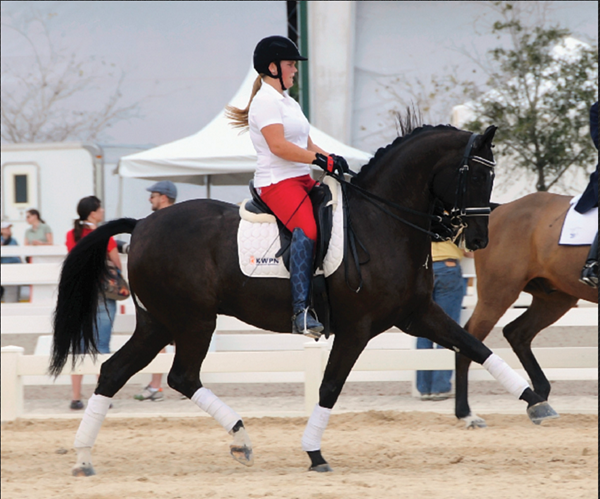
This photo shows Young Rider Jeanine Biemond and her horse Diamond, an 8-year-old Dutch Warmblood gelding. She has been riding dressage for two and a half years. The pair has been together about six months and they are now schooling Prix St. Georges.
This is a horse with a lot of power and talent, as you can see. He has a very engaged hind leg and looks eager to go forward. He is fairly short-coupled and has a strong back, so it seems likely that he’s an easier type to connect than a horse with a very long back and topline. The saddle looks like it might crowd his shoulder blade but that might be due to his short back. There may not be much room for the saddle to be placed differently but it may need to be checked out by a professional saddle fitter.
To make this picture better, I would like Jeanine to work on a few things. First of all, Diamond is slightly tight (or short) in his throatlatch and his nose could be just a bit more out on the vertical. I think this could be remedied by changing how she sits on her horse.
I don’t think Jeanine would be in a stable balance on her own if you took the horse out from under her. If you did so, she would, of course, land on her feet but would then fall backward or have to step backward to balance herself. I would like to push her upper body slightly more forward, so that she is on the vertical rather than behind it. Her seat bones should point straight down (instead of pointing fairly forward) in the saddle, which allows her to keep more bend in her knees so her lower leg stays under her. I also suggest she shorten her stirrups about two holes.
Even though this is such a nice moment in Diamond’s workout, these changes will allow him to show more freedom and self-carriage. He needs to feel through the rein that if the contact disappeared, nothing would change right away. If I imagine that in this photo, I think too much would be affected.
I also suggest that Jeanine imagine there is a wall in front of her that she needs to push her upper body into and another in front of her hands and do the same. These walls can give the sense of isometric strength Jeanine needs to match her horse’s forward energy (which is a lot from the looks of this photo). She will be able to have a rein contact that is more pushing and receiving than holding with a backward energy.
I like the shape of Jeanine’s upperbody in that she is not lifting her chest too far up and away from her core as many riders do. Her shoulders look well attached and are toned and held steadily down by her strong lats. This is better than having her shoulders so up and so far back that it puts the spine out of neutral. Neutral spine is optimal for a rider’s own balance and suppleness. A spine in neutral has a natural inward curve in the lumbar region and a natural outward curve in the thoracic region. I see many riders trying so hard to get their shoulders back—as they’ve probably been told to do—that they end up flattening the thoracic vertebrae into a very rigid and stiff shape.
These two certainly look like a promising pair to watch out for in the future. I wish them all the best.
Heather Blitz is a Grand Prix competitor and trainer. She is the United States alternate for the 2012 Olympic Games with her gelding, Paragon. Just last year the pair won team gold and individual silver medals at the Pan American Games in Guadalajara, Mexico.
No stranger to the international arena, Blitz joined the U.S. Equestrian Federation Long List while working as head trainer at Oak Hill Ranch in Louisiana, where she rode its DanishWarmblood stallion Rambo DVE 373. In 2006, she piloted the stallion’s daughter, Arabella, to the reserve spot on the World Equestrian Games team.
During her seven years at Oak Hill Ranch, Blitz rode a broodmare she loved so much that she decided to breed her, producing a horse by Blue Hors Don Schufro out of Pari Lord by Loran. The result was her Pan American partner, Paragon. After their success in 2011, the pair moved up to the Grand Prix during the winter season in Florida. They qualified for the World Dressage Masters 5* during Paragon’s CDI debut at that level, earning impressive scores.
Blitz holds a B.S. in equine science from Colorado State University. She credits her biomechanics coach, Mary Wanless, as the biggest influence on her development as a rider and instructor. They have been working together since 1993. Blitz is based in Wellington, Florida (heatherblitz.info).
Send Your Photo
You can submit your dressage photo for critique (300 dpi and four-by-six inches in size). Or you can send your photo with a link to a short video. E-mail to DressageToday@AimMedia.com. Turnout in dressage show or clinic appropriate attire is encouraged. Don’t forget your helmet!











